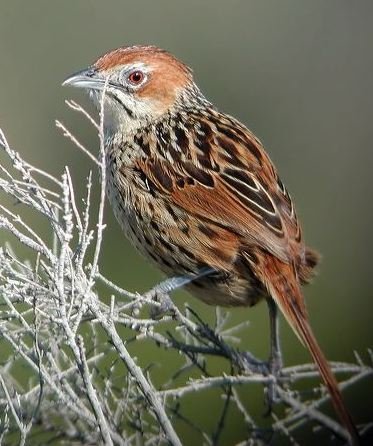Macrosphenidae – Crombecs, Longbills & African Warblers

The African warblers are a newly erected family Macrosphenidae, of passerines. Most of the species were formerly placed in the Old World warbler family Sylviidae, although one species, the rockrunner, was placed in the babbler family Timaliidae. A series of molecular studies of the Old World warblers and other bird families in the superfamily Sylvioidea (which includes the larks, swallows and tits) found that the African warblers were not part of the family Sylviidae but were instead an early offshoot (basal) to the entire Sylvioidea clade.
The African warblers inhabit a range of habitats in sub-Saharan Africa. These range from primary rainforest to forest edge and open woodland habitats for the longbills, wooded savanna to arid scrubland and bushland in the crombecs, rocky arid scree areas and grassland for the Rockrunner, and grassland for the moustached grass warbler and Cape Grassbird. The family is overwhelmingly non-migratory, although the Moustached Grass Warbler and the Northern Crombec both make some localised movements in West Africa related to the rainy season.
They range in size from the smaller crombecs, which measure 8 centimetres in length and weigh as little as 6.5 grams, to the Cape Grassbird, which measures 19–23 centimetres in length and the Moustached Grass Warbler which weighs 29–40 grams. There is considerable difference in appearance between the genera; for example the two grass warblers and Victorin’s Warbler possess long graduated tails, whereas the crombecs have tails of which barely extend beyond the tail coverts and folded wings.
They are insect eaters, and take a range of insect prey. The longbills and crombecs feed in the canopy and in bushes, either as singles or pairs and sometimes in small groups, whereas the other species are more terrestrial in their habits. Where two species co-occur, such as the Red-faced Crombec and the Long-billed Crombec over parts of their range, niche partitioning occurs, with one species feeding in the canopy and the other species feeding lower down in the bushes and trees. Some species of both crombec and longbill have been reported to join mixed-species feeding flocks.
Breeding is seasonal and usually timed to coincide with the end of the dry season and beginning of the rainy season; in species with large ranges this can lead to considerable variation as to the exact timing. Information is lacking in many species, but for those that have been studied the African warblers are territorial and monogamous. Nest design varies within the family; the crombecs construct deep pocket shaped nests suspended from a branch; whereas the Victorin’s Warbler, Cape Grassbird and Moustached Grass Warbler construct cup nests weaved from grass.
There are 18 species in this group. They are:
Moustached Grass Warbler Melocichla mentalis
Cape Grassbird Sphenoeacus afer
Rockrunner Achaetops pycnopygius
Yellow Longbill Macrosphenus flavicans
Kemp’s Longbill Macrosphenus kempi
Grey Longbill Macrosphenus concolor
Pulitzer’s Longbill Macrosphenus pulitzeri
Kretschmer’s Longbill Macrosphenus kretschmeri
Northern Crombec Sylvietta brachyura
Red-faced Crombec Sylvietta whytii
Philippa’s Crombec Sylvietta philippae
Long-billed Crombec Sylvietta rufescens
Somali Crombec Sylvietta isabellina
Red-capped Crombec Sylvietta ruficapilla
Green Crombec Sylvietta virens
Lemon-bellied Crombec Sylvietta denti
White-browed Crombec Sylvietta leucophrys
Victorin’s Warbler Cryptillas victorini
-
Cape Grassbird Sphenoeacus afer
IUCN Species StatusThe global population size has not been quantified, but the species is described as locally common (del Hoyo et al. 2006). -
Cape Grassbird Sphenoeacus afer
Species AccountSound archive and distribution map -
Cape Grassbird Sphenoeacus afer
Species AccountThe Cape grassbird or Cape grass warbler (Sphenoeacus afer) is an African warbler found in southern Africa. -
Moustached Grass Warbler Melocichla mentalis
IUCN Species StatusThe global population size has not been quantified, but the species is described as common throughout the north tropical Guinean savannah belt and less common and localised throughout the rest of its range (del Hoyo et al. 2006). -
Moustached Grass Warbler Melocichla mentalis
Species AccountSound archive and distribution map -
Moustached Grass Warbler Melocichla mentalis
Species AccountThe moustached grass warbler (Melocichla mentalis) is a species of African warbler, formerly placed in the Sylviidae family. -
Rockrunner Achaetops pycnopygius
Image -
Rockrunner Achaetops pycnopygius
Species AccountSound archive and distribution map -
Rockrunner Achaetops pycnopygius
Species AccountThe rockrunner (Achaetops pycnopygius), also known as the Damara rock-jumper, is a species of African warbler, formerly placed in the Sylviidae family. It is the only member of the monotypic genus Achaetops. It is found in Angola and Namibia.
